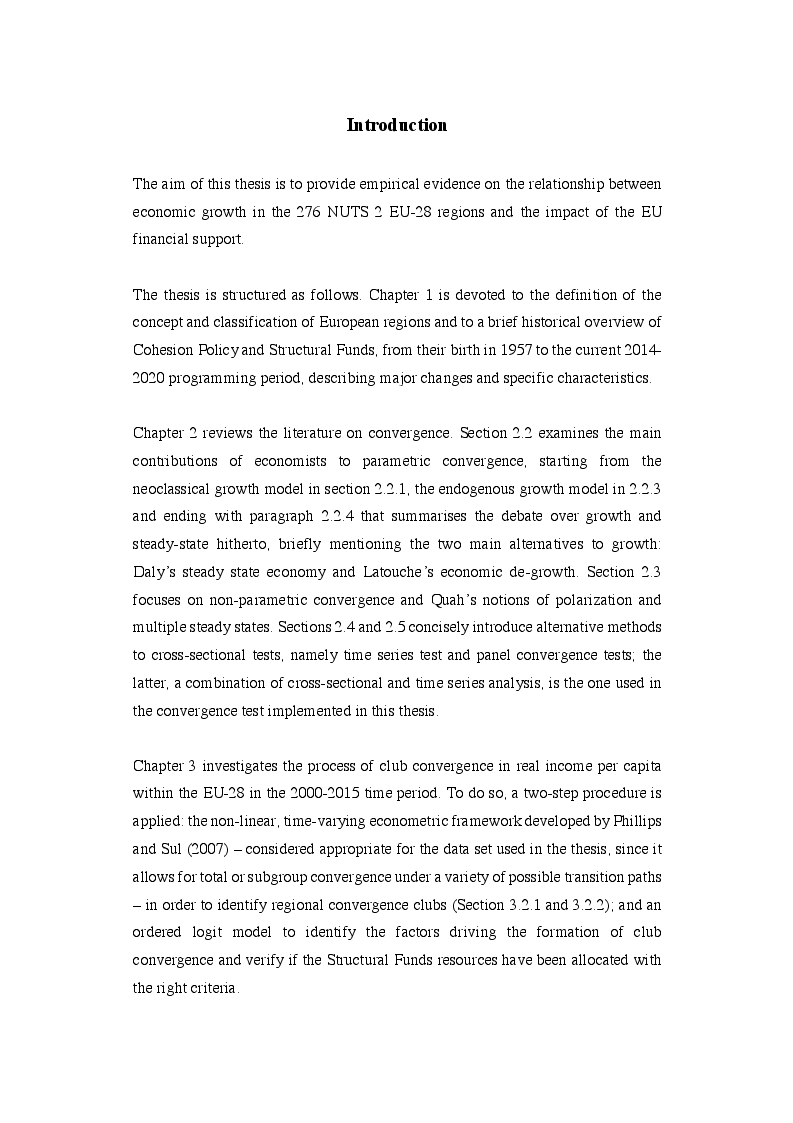EU Cohesion Policy and new convergence clubs
This study provides empirical evidence on club convergence among European regions and on the impact of regional peculiar structural features on club formation.
Building on previous EU convergence analysis, the main novelties are: the inclusion of new EU Member States from CEE in our sample; the use of GDP instead of GVA as our dependent variable; the inclusion of additional control variables to account for the socio-economic and demographic features of new Members; and a checkup on the resources allocations of EU Structural Funds to all regions.
To begin with, chapter 1 is devoted to the definition and classification of European regions and to a brief historical overview of Cohesion Policy and Structural Funds. Then, chapter 2 reviews the literature on convergence, from the neoclassical growth model to the more recent steady state economy and economic degrowth, also focusing on time series and panel convergence analysis.
Eventually, chapter 3 investigates the presence of club convergence in GDP per capita within the 276 NUTS 2 regions for the 2000-2015 time period. To do so, a two-step procedure is applied: first, the non-linear log t test developed by Phillips and Sul is implemented and six convergence clubs are identified; second, an ordered logit model is run to detect how structural characteristics drive the formation of such clubs. The final section 3.4 discusses the results obtained under the models’ conditions: each club shows specific features, starting from club 1, where North-Western and also Central-Eastern capital regions converge to the same steady state, and ending with club 6, where the dramatic effects of the 2009 crisis inevitably made Southern and some CEE regions cluster together in the lowest GDP club. Such cluster structure is well reflected by the results from the ordered logit model, which highlighted the strong impact mostly of population density, unemployment rates, GVA in industry and in financial activities on the clubs formation.
CONSULTA INTEGRALMENTE QUESTA TESI
La consultazione è esclusivamente in formato digitale .PDF
Acquista

CONSULTA INTEGRALMENTE QUESTA TESI
La consultazione è esclusivamente in formato digitale .PDF
Acquista
Informazioni tesi
| Autore: | Chiara Pontillo |
| Tipo: | Tesi di Laurea Magistrale |
| Anno: | 2016-17 |
| Università: | Università degli Studi di Bologna |
| Facoltà: | Scienze Politiche |
| Corso: | Sviluppo locale e globale |
| Relatore: | Cristina Brasili |
| Lingua: | Inglese |
| Num. pagine: | 122 |
Forse potrebbe interessarti la tesi:
La politica regionale di coesione economica e sociale dell'Unione Europea
FAQ
Come consultare una tesi
Il pagamento può essere effettuato tramite carta di credito/carta prepagata, PayPal, bonifico bancario.
Confermato il pagamento si potrà consultare i file esclusivamente in formato .PDF accedendo alla propria Home Personale. Si potrà quindi procedere a salvare o stampare il file.
Maggiori informazioni
Perché consultare una tesi?
- perché affronta un singolo argomento in modo sintetico e specifico come altri testi non fanno;
- perché è un lavoro originale che si basa su una ricerca bibliografica accurata;
- perché, a differenza di altri materiali che puoi reperire online, una tesi di laurea è stata verificata da un docente universitario e dalla commissione in sede d'esame. La nostra redazione inoltre controlla prima della pubblicazione la completezza dei materiali e, dal 2009, anche l'originalità della tesi attraverso il software antiplagio Compilatio.net.
Clausole di consultazione
- L'utilizzo della consultazione integrale della tesi da parte dell'Utente che ne acquista il diritto è da considerarsi esclusivamente privato.
- Nel caso in cui l’utente che consulta la tesi volesse citarne alcune parti, dovrà inserire correttamente la fonte, come si cita un qualsiasi altro testo di riferimento bibliografico.
- L'Utente è l'unico ed esclusivo responsabile del materiale di cui acquista il diritto alla consultazione. Si impegna a non divulgare a mezzo stampa, editoria in genere, televisione, radio, Internet e/o qualsiasi altro mezzo divulgativo esistente o che venisse inventato, il contenuto della tesi che consulta o stralci della medesima. Verrà perseguito legalmente nel caso di riproduzione totale e/o parziale su qualsiasi mezzo e/o su qualsiasi supporto, nel caso di divulgazione nonché nel caso di ricavo economico derivante dallo sfruttamento del diritto acquisito.
Vuoi tradurre questa tesi?
Per raggiungerlo, è fondamentale superare la barriera rappresentata dalla lingua. Ecco perché cerchiamo persone disponibili ad effettuare la traduzione delle tesi pubblicate nel nostro sito.
Per tradurre questa tesi clicca qui »
Scopri come funziona »
DUBBI? Contattaci
Contatta la redazione a
[email protected]
Parole chiave
Tesi correlate
Non hai trovato quello che cercavi?
Abbiamo più di 45.000 Tesi di Laurea: cerca nel nostro database
Oppure consulta la sezione dedicata ad appunti universitari selezionati e pubblicati dalla nostra redazione
Ottimizza la tua ricerca:
- individua con precisione le parole chiave specifiche della tua ricerca
- elimina i termini non significativi (aggettivi, articoli, avverbi...)
- se non hai risultati amplia la ricerca con termini via via più generici (ad esempio da "anziano oncologico" a "paziente oncologico")
- utilizza la ricerca avanzata
- utilizza gli operatori booleani (and, or, "")
Idee per la tesi?
Scopri le migliori tesi scelte da noi sugli argomenti recenti
Come si scrive una tesi di laurea?
A quale cattedra chiedere la tesi? Quale sarà il docente più disponibile? Quale l'argomento più interessante per me? ...e quale quello più interessante per il mondo del lavoro?
Scarica gratuitamente la nostra guida "Come si scrive una tesi di laurea" e iscriviti alla newsletter per ricevere consigli e materiale utile.
La tesi l'ho già scritta,
ora cosa ne faccio?
La tua tesi ti ha aiutato ad ottenere quel sudato titolo di studio, ma può darti molto di più: ti differenzia dai tuoi colleghi universitari, mostra i tuoi interessi ed è un lavoro di ricerca unico, che può essere utile anche ad altri.
Il nostro consiglio è di non sprecare tutto questo lavoro:
È ora di pubblicare la tesi

